If the garage is not heated during the cold season, condensation forms on the surfaces and constant dampness is present. Such conditions will not benefit the vehicle and the occupants. If the installation of local heating is not possible, there is an excellent solution in all respects - to make a potbelly stove in the garage and stock up on fuel. This work is simple, but requires certain knowledge and skills in working with electrical equipment.
- Features and principle of operation of the stove
- Pros and cons of a homemade potbelly stove for a garage
- Which potbelly stove is better for a garage
- On wood or waste oil
- What to make a potbelly stove in a garage
- Required materials and tools
- Varieties of designs
- Making a classic stove-potbelly stove
- Diy potbelly stove from a pipe or barrel
- Stove stove from a gas cylinder
- From rims
- Safety engineering
- Ways to improve heat transfer and furnace efficiency
Features and principle of operation of the stove
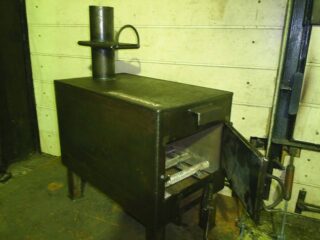
A potbelly stove is a self-contained device that releases heat when solid or liquid fuel is burned in it.
The standard device has the following device:
- Housing. It contains a firebox with a door and grate bars for fuel storage.
- It blew. It is an air intake hole. At the same time it serves to extract ash falling out through the grate.
- Chimney. Designed to remove combustion products and create the necessary thrust for it. Equipped with a damper and a cap to protect against rain, debris and small animals. The minimum pipe height is 400 cm.
The principle of operation is as follows: the fuel burns, oxygen is supplied through the blower to maintain the process. The walls of the hearth are heated, the smoke goes into the chimney due to the draft, the ash is poured into the ash pan.
According to the direction of the location of the furnace, the furnaces are subdivided into vertical and horizontal. Depending on the design, their efficiency is 40-85%.
Pros and cons of a homemade potbelly stove for a garage
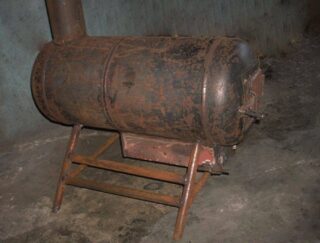
Like any heating structure, a welded stove has its positive and negative features. They must be taken into account when choosing a model.
Advantages of homemade heaters:
- small manufacturing costs, in most cases recyclable materials are used for this;
- versatility, since all types of fuel can be used, including waste disposal;
- ease of assembly that does not require professional skill;
- rapid heating of the room due to the release of heat over the entire area of the building
- the possibility of modernization under the stove, hot water device and dryer due to additional radiators;
- independence from the availability of electricity, water, gas and other central supply resources.
Cons of iron heaters:
- significant heat loss, accompanied by high fuel consumption;
- the need for constant fuel loading, since the metal quickly cools without burning;
- choice of quality material, thin metal quickly burns out;
- risk of carbon monoxide poisoning;
- high fire hazard due to the possibility of overturning.
The chimney needs quality material. For the exit to the street, you will have to make a hole in the wall or ceiling and roof.
Which potbelly stove is better for a garage
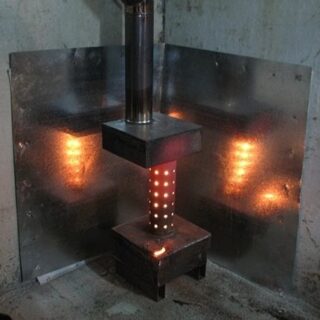
To determine which is better to cook a potbelly stove in the garage with your own hands, you should evaluate a number of criteria corresponding to a particular case.
Factors influencing the choice:
- Availability of a particular type of fuel in the region. We are talking about free raw materials and purchased, if large and regular deliveries are needed.
- Required space heating efficiency. Here you need to take into account its size, configuration, required temperature.
- Device autonomy. If heating is needed sporadically, the simplest device is enough, where branches, wood chips and paper waste will be burned for several hours. When heat is needed constantly, you need to make more expensive, but economical devices for long burning.
On wood or waste oil
These fuels are the most common in almost all regions of the country. There are scaffolding and service stations everywhere. In one place there is a lot of dead wood and dead wood, in another there is mining. Both can be taken free of charge, or for a symbolic amount.
There is no need for special storage conditions for firewood; it is enough to fold it under a canopy against the wall or in the corner of the garage. But the wood burns out quickly and leaves a lot of soot in the firebox and chimney.
Machine oil gives a lot of energy, with the correct setting, no soot is emitted, one refueling can last up to 12 hours with a fairly effective heat transfer. The likelihood of fire is extremely low. For storage, special containers are required; during operation, a characteristic smell and noise are emitted. The coked layer in the firebox is extremely difficult to clean.
What to make a potbelly stove in a garage
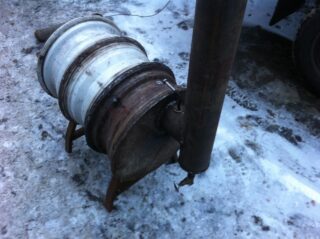
To make a garage heater, you can take as a basis:
- gas cylinder;
- wheel disks;
- a steel barrel with thick walls;
- iron sheets.
The choice is determined by the purpose of the work, the planned life of the device and the availability of available materials.
Required materials and tools
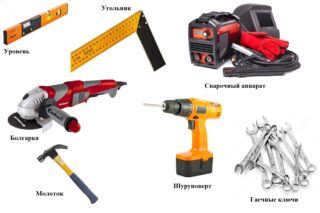
The wizard will need tools:
- level;
- square;
- welding;
- Bulgarian;
- screwdriver;
- spanners;
- electric drill;
- hammer, paint brush.
List of materials:
- metal (sheets or blanks);
- primer;
- corner 30x30 mm;
- reinforcement 10-12 mm;
- bolts and nuts 6 mm;
- chimney and branch pipe;
- accessories - hinges, handles, latches.
For work, you should prepare a flat base and protective equipment - a robe, mask, glasses and gloves.
Varieties of designs
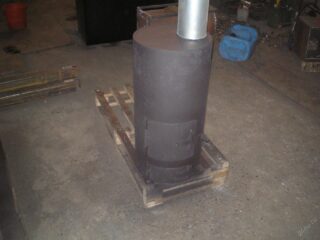
Potbelly stoves can be made in various designs and sizes. Each master chooses the best option for himself.
Horizontal hearths are more efficient in terms of heat release, since their body is located next to the floor and heats the lower part of the room better due to its orientation. In addition, the longitudinal position allows more fuel to be stacked in a thin layer.
Vertical heaters take up less space, but the main heat from them is concentrated from above, which leaves cold air in the floor area.
The grates are welded inside the firebox or placed on fasteners welded to the walls of the firebox from the inside.
Making a classic stove-potbelly stove
A classic do-it-yourself potbelly stove in a wood-fired garage is made from sheets of iron 3-4 mm thick, the thicker the better. Material for work can be found in abandoned factories, construction sites or scrap metal collection points. A high vertical parallelepiped is welded, grate bars are inserted inside, doors for the firebox and blower are made. After that, the bottom and top are closed with iron plates. It is advisable to cook from the outside and from the inside to eliminate cracks.
Diy potbelly stove from a pipe or barrel
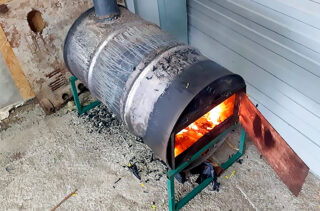
Pipes and barrels are easy to use and are excellent shell blanks. For both items, you will need to make technological holes and install grates. The pipe will require thick iron plates to cover the ends. They can be made larger to increase the heat dissipation area, or used as a drying and cooking panel.
Stove stove from a gas cylinder
Used products pose a great risk of explosion of fuel residues. They can be cut and welded with the neck removed and completely filled with water. After that, you can hang the doors and put the pipe connection. It is necessary to take into account the configuration of the cylinder: for it you need to make a wide and solid base in order to exclude the slightest probability of falling.
From rims
In the manufacture of these products, durable, heat-resistant steel is used. Assembly technology involves cutting the internal parts and connecting the fragments into a pipe. Then everything is done according to a scheme similar to one-piece workpieces - installation of grates, doors, bottom and top, connection of a chimney.
The best option for placing the heater in the garage is the corner of the room. There should be no flammable objects, fuel, liquids and furniture nearby. There must be a distance of at least one meter to the machine.
Safety engineering
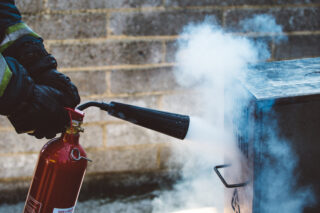
When operating a stove, it is prohibited:
- leave a working device unattended;
- use gasoline and acetone for ignition;
- overload the furnace with fuel;
- use the heater in the absence of draft;
- install horizontal sections of the chimney longer than 200 cm.
In the garage, you need to have a supply of water, sand, powder and acid fire extinguishers, preferably a fire alarm.
Ways to improve heat transfer and furnace efficiency
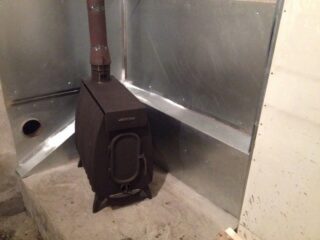
You can improve the efficiency of the hearth in the following ways:
- install a heat-reflecting screen near the device;
- weld several wide plates to the body;
- equip a blower from above by building a two-chamber firebox.
Each method requires certain costs, but significantly increases the efficiency of heating.
Before the first combustion, the product must be checked to make sure there are no through holes. If you equip a water tank and a small piping loop at the top of the hearth, a significant part of the heat will not be lost. The main thing is to prevent the liquid from freezing. It is possible to increase the heating time of the room after the fuel burns out by covering the stove body with fireclay bricks placed on a clay mortar.








